Because I'm weird and my brain generally works the opposite of what logic would dictate, making a new project for myself seems to have set everything into alignment. I don't know why. What I do know is 1) I've learned more about Arizona nature and especially Arizona's animals in the last few years than in all my animal-obsessed childhood years combined; 2) I am pretty good at nature photography; and 3) people tend to ask me about Arizona animals, and I enjoy being a know-it-all about them. So this week marks the first roundup week of my self-imposed "Species a Day" project: A different Arizona animal species each day, with previously unshared photographs and a brief writeup.
This past week's animals follow. What animals would you like to see? I'm game for anything, as long as it's an Arizona animal (though it doesn't have to be exclusively an Arizona animal, as in most cases).
Day 1: Cactus wren
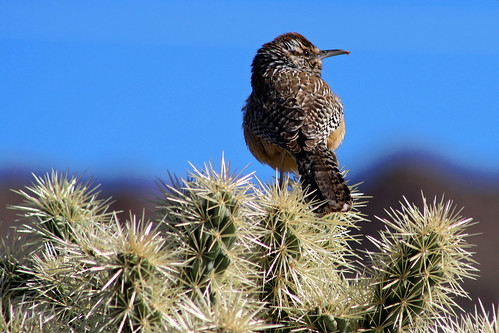
Our state bird. Bold. Feisty. Fond of scolding anyone who crosses its path with loud, raspy, ceaseless vocalizations. You know, a typical Arizonan.
 |
| Nah. Wrens probably talk less often. |
Cactus wrens, Campylorhynchus brunneicapillus, are the largest of our wrens, at 22 centimeters. They're the most striking, too, in my opinion: They've got bright white streaks over each eye, sort of like the freaky eyebrows on that juicer guy; and they have beautifully streaked and speckled breasts.
Cactus wrens are year-round residents across much of
 Arizona and are especially fond of (you guessed it) cactus country. Cholla are their favorites, and they tuck their nests inside the wicked branches of these most wicked of cacti. The ground surrounding every cholla (and thus every cactus wren home) is perpetually covered in cactus-branch land mines, which spent the better part of my childhood attached to various parts of my anatomy. (I had a branch lodged in my foot while taking these images, as a matter of fact. Not fun. Tip: Don't wear sandals while chasing cactus wrens.)
Arizona and are especially fond of (you guessed it) cactus country. Cholla are their favorites, and they tuck their nests inside the wicked branches of these most wicked of cacti. The ground surrounding every cholla (and thus every cactus wren home) is perpetually covered in cactus-branch land mines, which spent the better part of my childhood attached to various parts of my anatomy. (I had a branch lodged in my foot while taking these images, as a matter of fact. Not fun. Tip: Don't wear sandals while chasing cactus wrens.)If you can manage to navigate safely through that, there's no way you'll reach the nest. Cactus wren nests are generally only accessible to cactus wrens. You'd think, then, that they'd be calm and secure. Not so.
Cactus wrens are freakishly alert, ever vigilant, and noisy. I approached one. Cha! ChaChaChaChaChaCha! It flew away. I slowly (after yanking a huge cholla branch from my ankle) approached again. ChaChaChaChaChaChaCHACHA! I watched it go. I sat on the ground and waited for it to come to me (after removing the cactus branch on which I'd sat). It returned. With a friend!


I excitedly got off one snap before getting it in stereo. CHACHASCREWYOU! Finally, I settled for not moving my lens, not moving my head, and locking my eyes on his home cactus. Eventually, after several minutes, he landed one last time, lacing his scaly toes through the cholla spines, and I got a few more shots in before failing to lace my own toes safely through the spines that were at my feet. I used the "comb method" to remove this branch (stick a comb in; yank really hard; curse), and as beads of blood welled and I got hollered at again by the wren, I called it a day. Birding is hard work, y'all. (Actually, I had a blast. Plus, this was the guy that inadvertently led me here.)
Day 2: Verdin
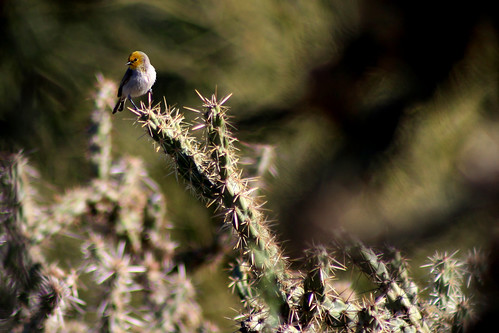
In the same area as the cactus wrens, I saw (and actually managed to capture) a verdin, or Auriparus flaviceps, perched on a staghorn cholla.
I'll share my husband's wisdom on the matter:
Husband: "What's a verdin?"
Me: "I think it's a type of tit."
Husband: "... (snickersnicker) ..."
Me: "Really?"
Husband: [Laughing like a 10-year-old]
It only got worse when I mentioned that it's related to the bushtit. We have this type of conversation often. You can imagine his appreciation of the recent animal-name hi-jinks on Jeopardy.
Seriously, I have the hardest time capturing verdins. They're these tiny sprites of birds (about 11 centimeters) that flit around in arid scrub, building little spheres of nests. They're gorgeous. And I never noticed them until I started purposely looking.
Day 3: Green lacewing

I photographed this green lacewing (Genus Chrysoperla, I believe -- anyone know the specific species name?) on my window in the morning. I love these guys. They're delicate and gorgeous, their eyes are iridescent, and they eat aphids. They're only a couple of centimeters long. They're attracted to lights at night like moths, except they're more jittery and fluttery than moths when they fly. (More jittery and fluttery. See how scientific I am?) Sometimes in the summer, they'll lay eggs on tiny hair-like filaments, with a miniature bubble of an egg at the tip of each fiber. My son commented that "they're like party balloons, only with insect eggs," which probably tells you quite a bit about how my family sees the world.
Day 4: Blue-eyed darner

Love these guys. This was the first dragonfly I remember ever seeing, and their eyes remind me of Fremen, so of course I'm pretty fond of the critters. For some reason, I have the hardest time capturing clear photos of these darners, which seem a tad more cautious than some other dragonflies in Arizona. Still, I liked this image.
The blue-eyed darner, Aeshna multicolor, is about 7 centimeters long. It seems to like perching on sage bushes and similar foliage. The female is marked similarly to the male, except with green instead of blue.
Day 5: Great-tailed grackle
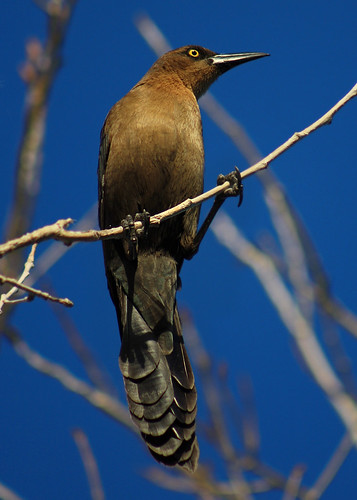
Maybe kind of a cheat, as they're so easy, but I really don't think there's a "boring" critter out there, and if there was, it certainly wouldn't be great-tailed grackles, or Quiscalus mexicanus. These guys are a blast to watch. They're not, as some people think, cousins of crows, but they still seem pretty darn intelligent. A male grackle will sit up in a tree, seemingly waiting for his harem of females below to scout out potential foraging grounds.

These are some of my son's favorite birds, and I think it's because they're so dang entertaining. Their mating "dance" is hilarious: The male will sort of stiffen and vibrate/jiggle himself about, like a broken wind-up toy, with feathers puffed out, while the female feigns indifference. (So, not so unlike people, I guess.) They squabble. They're fiercely opportunistic. Once I spilled a bag of cat food in the grocery store parking lot. I was set upon by an energetic cacophonous cloud. They're awesome.
Day 6: Curve-billed thrasher
Growing up, we had a water dish in our backyard that was frequented, most often, by cactus wrens and curve-billed thrashers, or Toxostoma curvirostre. As I said above, the wrens were feisty and noisy and just seemingly crude. The thrashers, on the other hand, gave the appearance of a sort of haughty polish. Their sickle-shaped bills looked like some kind of cultured restraint, and they lightly loped about, calling out less often, and then only with a sweet, short, whit-weet. They seemed more polite, somehow.
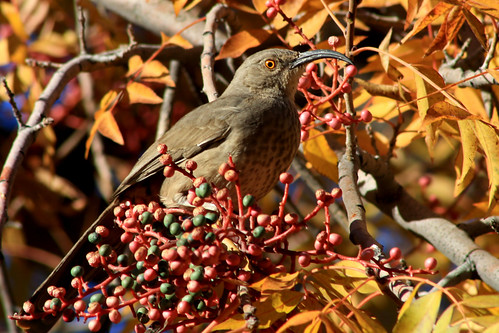 |
| I totally think I'm better than you. |
This was an illusion. The thrashers would wait. They would stand about with their snobbish looks, prissily whit-weeting at the cactus wrens, and then, while the wrens were busy telling everyone how great they were, the thrahsers would move in, drink the water, and eat all the seed.
Curve-billed thrashers can be hard to tell from the closely related Bendire's thrashers. Curve-billed thrashers, at about 28 centimeters, also have lighter and more spotted breasts than the Bendire's, at about 25 centimeters -- and also, suprise, more curved bills.
Day 7: Great blue heron
If you've browsed this blog at all, you've almost definitely seen photos of this bird before. The great blue heron, Ardea herodias, begs to be photographed pretty much any time you spot it. If you live in the area, go to the Gilbert Riparian Preserve, where you're bound to see a few zillion other bird species if the herons don't tickle your fancy. If you get there while there's still a decent amount of daylight left, hike to one of the inner ponds. Find a secluded spot at the water's edge. Just sit. And wait. They'll come.
Great blue herons live throughout North America, and are pretty adaptable to different locations, though they'll always be near a body of water, and usually nest in nearby trees. If, like me, your first encounter is an accident, and you learn the heron's alarm call (an abnormally loud, abnormally un-birdlike, harsh croak-grunt) as it flies out of a concealing bush like a pterodactyl, your first heron encounter might coincide with your first heart attack.
Also, they're awesome fishers. They stalk. Plunge. Gobble. And repeat. And I never tire of watching. (One last tip. Stay out from beneath them. OMG.)
 |
| The approach |
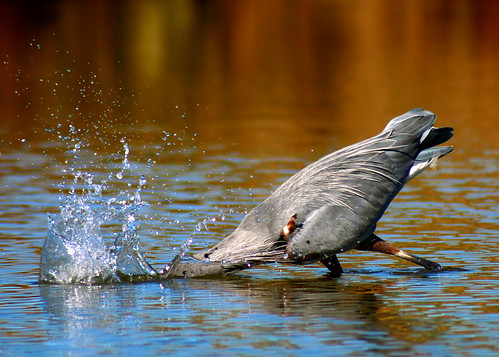 |
| The attack |
 |
| The reward |
And that's it, for this week. I'll post another species each day, and gather them up each Monday. I think I should be able to go at least a year. What do you think?
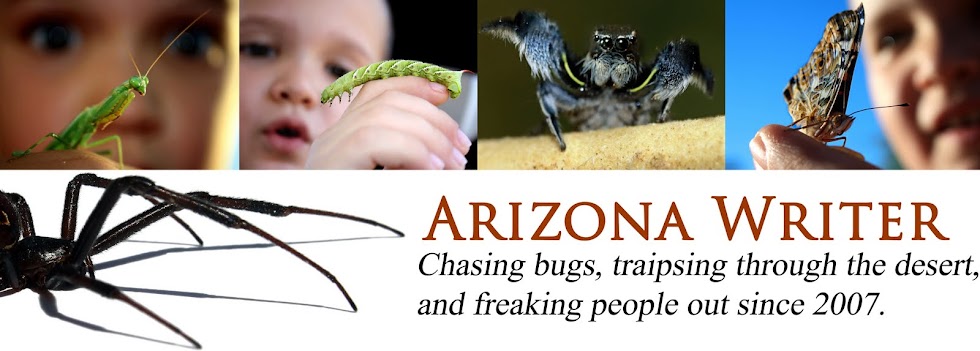
7 comments:
Love your species a day post!!
Your photographs are magnificent and the perspective and point of view from which you shoot is remarkable - good stuff!!
I'm trying my hand at catching a new finch at the feeder this week but man are they fast :)
Thank you!
I have a finch coming up too, actually. You're right; they are fast. For every impressive bird photo I have, there are probably three of an empty rock/empty branch/bird-shaped blur.
Oh my. I adore this series.
And I may have also giggled. What? hehe
what amazing pics!
esp love the series with the heron and the dragonfly!!!
FireMom: You'll really love this post, then.
creativespiderbite: Thanks! I think those are some of my favorites too, though my favorites tend to change daily.
I Also love this species a day post...I'm thinking another trip to Arizona is in order. I loved Organ Pipe NM! Great job on the pics. You must also have great patience to be still! :-)
Just discovered you via G+ and love the species a day since I'm a bio teacher / nature photographer. You are SUCH a great Nature Geek! It's always great to encounter other like minded people! Cheers from North Texas!
Post a Comment